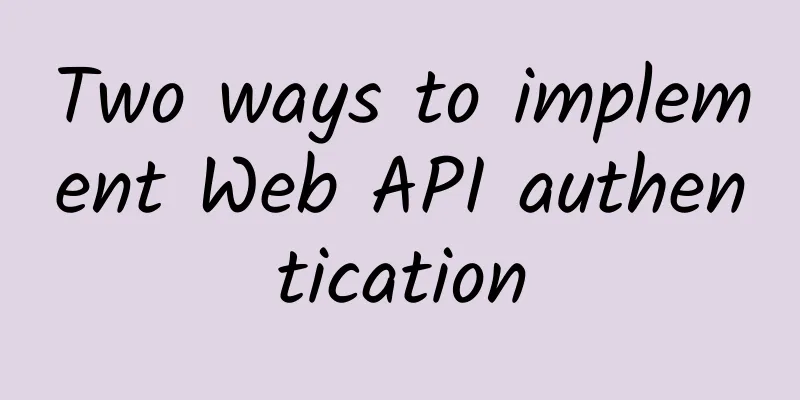Two ways to implement Web API authentication

|
Preface The so-called authentication is ultimately a security issue. There are many ways to implement security in Web API, such as the [accepted] method to handle IIS-based security (via WindowsIdentity mentioned in the previous section that relies on HttpContext and IIS authentication) or by using the message processing mechanism in Web API. However, if we want the application to run outside of IIS, the Windows Idenitity method seems unlikely. At the same time, Web API itself does not provide a direct way to handle authentication. We have to customize it to implement the authentication function. This is also the method we recommend, do it yourself and have enough food and clothing.
From the rough information in the above picture, we can see that the request to the Action method must go through the Web API message processing pipeline, and before the request to the target element, it must go through the HttpMessageHandler and the authentication filter, so we can customize the authentication through these two. Let's take a look at them one by one. We customize a class for authentication identity (user name and password), so this class must also inherit from GenericIdentity. Since it is based on basic verification, the type is of course Basic.
We need to customize an authentication filter feature and inherit AuthorizationFilterAttribute, which will become as follows:
So what should we write in this rewritten method? Let's analyze it slowly! Please read on. Parsing request header First of all, for the request sent by the client, we must obtain the request header, and then parse the Authorization in the request header. If its parameter is empty at this time, we will return to the client and initiate a query.
Next, we will initiate an authentication challenge if the authentication fails. We will encapsulate it into a method Challenge
Define a method to verify the username and password, and modify it as a virtual method to avoid adding other user data later.
After successful authentication, set the authentication identity to the Principal attribute in the current thread
Everything is ready, now you can make the corresponding call in the rewritten method, as follows:
#p#
Customize CustomBasicAuthenticationFilter and inherit from BasicAuthenticationFilter, overriding its virtual methods.
Registering custom authentication attributes and calling them
At this point, the authentication method has been fully implemented. Next, we will use [Sogou Browser] to verify our results. Seeing the following picture of verifying its username and password, we know we are halfway there We click Cancel and observe whether 401 is returned and the query header WWW-Authenticate is added, as we expected. We enter the correct username and password and try again. The authentication is successful, as follows: Implementing authentication based on Web API message processing pipeline (HttpMessageHandler) We know that HttpMessageHandler is an important role in the message processing pipeline in the request-response of Web API, but the one that really implements the pipeline connection is DelegatingHandler. If you don't understand the Web API message pipeline, please refer to the previous series of articles, so we can customize the pipeline to intercept by inheriting DelegatingHandler. Let's implement authentication based on this pipeline step by step. It is the same as the first method and will not be described again. This step is of course to customize the pipeline for processing and inherit DelegatingHandler, overload the SendAsync method in this class, and respond by obtaining its request and processing it. If you don’t understand the specific implementation of this class, please refer to the previous series of articles. We also need to parse the request header according to the request. We still need to parse the header method, but we need to modify it slightly.
The query must also be modified accordingly, because it no longer relies on the Action request context, but on the request (HttpRequestMessage) and response (HttpResponseMessage)
The code that finally inherits from DelegatingHandler is as follows
#p# The above-mentioned custom BasicAuthenticationFilter must inherit AuthorizeAttribute at this time. This feature is also inherited from the above-mentioned AuthorizationFilterAttribute. We need to use the IsAuthorized method in AuthorizeAttribute to verify whether the Principal in the current thread has been authorized.
From the return value of the IsAuthorized method, if it is false, a 401 status code is returned, which triggers a challenge in BasicAuthenticationHandler, and this method mainly contains the business logic code for authenticating users. At the same time, we also said that the filter feature of our first method is AuthorizationFilterAttribute (if we have more logic to use this feature, it is a good choice), and here it is AuthorizeAttribute (for authenticating users and returning bool values, using this filter feature is a good choice). Registering custom pipe and authentication filter traits
***step [BasicAuthenticationFilter] Next, we will use [360 Speed Browser] to check the results. Click the button to directly request the controller Next, cancel and return 401 This is the end. |
<<: Our greatest creations come from borrowing, plagiarizing, and reshaping
>>: Remember, visual design is more than just “looking good”
Recommend
How to use data for brand marketing?
In this era, data-driven thinking is a quality th...
Mosquitoes don’t like blood type O the most, but…
Summer is here, While enjoying "small beer a...
How much does it cost to be an agent of a steel mini program in Tongchuan?
What is the price of Tongchuan Steel Mini Program...
Android 10 is finally here, and these are the only phones that can use it!
At the Google I/O 2019 Developer Conference, Goog...
The Secret of Zircon: I Know What Dinosaur Fossils Went Through
More than 70 million years ago, tens of thousands...
Miscellaneous notes on using git
Preface As a developer, if you don't know git...
Why are there no two identical leaves in the world? Here comes the truth!
Why are there no two identical leaves in the worl...
Which is better, the first generation iPhone or the first generation Android phone?
Google started developing the Android system as e...
After analyzing the pain points of 100 copywriting articles, we found that 99% of them are not really painful!
I have recently collected some articles about cop...
Foshan jewelry mini program customized development, who is the best jewelry mini program?
With the opening of various functions of mini pro...
Little Red Book Promotion Notes Marketing Strategy!
If you ask me which platform users enjoy watching...
Recommend 5 information flow advertising case libraries, take them for free!
It is really difficult to make information flow a...
Porsche may stop using diesel engines as Volkswagen scandal spreads, 20,000 Cayennes will be recalled
After nearly two years of investigation, the &quo...
A 10,000-word article deconstructs the logic of the e-commerce live streaming industry
Live broadcast, live broadcast, live broadcast......









